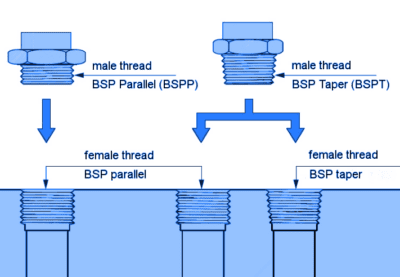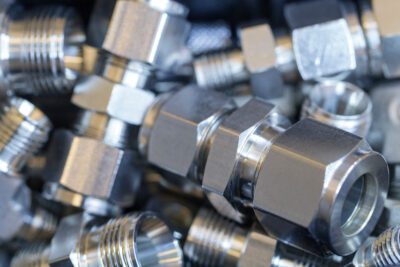 Precision and compatibility are critical when it comes to threading. Thus, industries like manufacturing, piping, and engineering must understand the differences across the various threading types for effective application.
Precision and compatibility are critical when it comes to threading. Thus, industries like manufacturing, piping, and engineering must understand the differences across the various threading types for effective application.
Keep reading to understand the thread concept, focusing on the British Standard Pipe (BSP) threads and the Metric threads so you understand their measurement systems, origins, and common applications.
Thread Identification Fundamentals
In the intricate world of flow control engineering, thread identification goes beyond mere specifications.
For professionals, it's about ensuring seamless operations and avoiding costly inefficiencies. This section delves into the intricacies of thread pitch vs. count, diameter, form, and classes, emphasizing their relevance in the flow control sector.
- Thread Pitch vs. Thread Count: A foundational distinction lies between thread pitch and thread count. Metric threads are characterized by the distance between threads, measured as pitch in millimeters. In contrast, BSP threads use the number of threads per inch as a defining parameter.
- Thread Diameter: Beyond pitch and count, the nominal thread diameter is a pivotal metric. Whether in millimeters for Metric or inches for BSP, precise tools like calipers or micrometers are essential for accurate measurements.
- Thread Form & Profile: The thread's profile, encompassing its angle, shape, and depth, is crucial for compatibility. Mating threads with incompatible forms can lead to inefficiencies, leakage, or mechanical failures.
- Thread Classes: Threads are also classified based on their tolerance and allowance specifications. These classes determine the ease of assembly and the tightness of the connection, which is crucial for applications requiring high precision or load-bearing capacity.
Metric Threads: Precision and Universality
 Metric threads, a staple in the metric system, are renowned for their precision and uniformity. Their global acceptance is a testament to their reliability, making them a preferred choice in various industries, including aerospace and automotive. World Wide Metric's product offerings underscore the versatility and precision of Metric threads, catering to diverse flow control applications.
Metric threads, a staple in the metric system, are renowned for their precision and uniformity. Their global acceptance is a testament to their reliability, making them a preferred choice in various industries, including aerospace and automotive. World Wide Metric's product offerings underscore the versatility and precision of Metric threads, catering to diverse flow control applications.
- Origins & Adoption: Rooted in the metric system, Metric threads have gained global acceptance due to their uniformity and precision. Their standardized nature simplifies international collaboration and component interchangeability.
- Applications: Beyond general-purpose applications, Metric threads are integral in industries like aerospace, automotive, and electronics. Their precision and reliability under varying pressures make them indispensable.
- Varieties: Metric threads come in coarse, fine, and extra-fine varieties, each suited for different applications. While coarse threads are more robust and assemble faster, fine threads offer better load distribution and are used in thin-walled structures.
BSP Threads: Specialization and Sealing

BSP threads, integral to fluid systems and rooted in the British imperial system, come in two distinct types: parallel (BSPP) and tapered (BSPT). BSPP threads are primarily used in mechanical joints where external seals, like washers, are employed, while the tapered design of BSPT threads makes them ideal for creating self-sealing, leak-proof connections in fluid systems, particularly vital in hydraulic systems and water distribution networks.
This dual functionality of BSP threads is highlighted in World Wide Metric's product range, which includes valves, fittings, and flanges, demonstrating the versatility and necessity of these threads in ensuring reliable and efficient flow control in various applications.
- Origins & Legacy: BSP threads, originating from the British imperial system, have a strong foothold in the UK and Commonwealth nations. Their design is tailored for specific applications, making them less universal but highly specialized.
- Applications: BSP threads are the gold standard in fluid systems, ensuring leak-proof connections. Their design excels in applications like hydraulic systems, water distribution networks, and gas pipelines.
- Varieties: BSP threads are unique in offering both parallel (BSPP) and tapered (BSPT) versions. While BSPP is used for mechanical joints, BSPT, with its self-sealing design, is ideal for pipes and fittings in fluid systems.
Making an Informed Choice
 While both Metric and BSP threads have their unique strengths, there are instances where conversion becomes necessary.
While both Metric and BSP threads have their unique strengths, there are instances where conversion becomes necessary.
World Wide Metric offers a plethora of adapters and fittings to ensure compatibility. Moreover, with the advent of Industry 4.0 and smart manufacturing, it's imperative for engineers to stay abreast of evolving thread standards and solutions.
Conclusion
For flow control engineers, threads are a confluence of design, functionality, and innovation. As the industry landscape transforms, a profound understanding of threads remains pivotal. World Wide Metric stands as a trusted partner, offering a comprehensive range of products to meet the dynamic needs of the flow control sector.
For All Your Thread-Related Needs
Including adapters, fittings, and more, contact us today! Our extensive catalog offers various solutions to meet your specific requirements.
CONTACT US TO LEARN HOW

 Precision and compatibility are critical when it comes to threading. Thus, industries like manufacturing, piping, and engineering must understand the differences across the various threading types for effective application.
Precision and compatibility are critical when it comes to threading. Thus, industries like manufacturing, piping, and engineering must understand the differences across the various threading types for effective application. Metric threads, a staple in the metric system, are renowned for their precision and uniformity. Their global acceptance is a testament to their reliability, making them a preferred choice in various industries, including aerospace and automotive. World Wide Metric's
Metric threads, a staple in the metric system, are renowned for their precision and uniformity. Their global acceptance is a testament to their reliability, making them a preferred choice in various industries, including aerospace and automotive. World Wide Metric's 
 While both Metric and BSP threads have their unique strengths, there are instances where conversion becomes necessary.
While both Metric and BSP threads have their unique strengths, there are instances where conversion becomes necessary.















